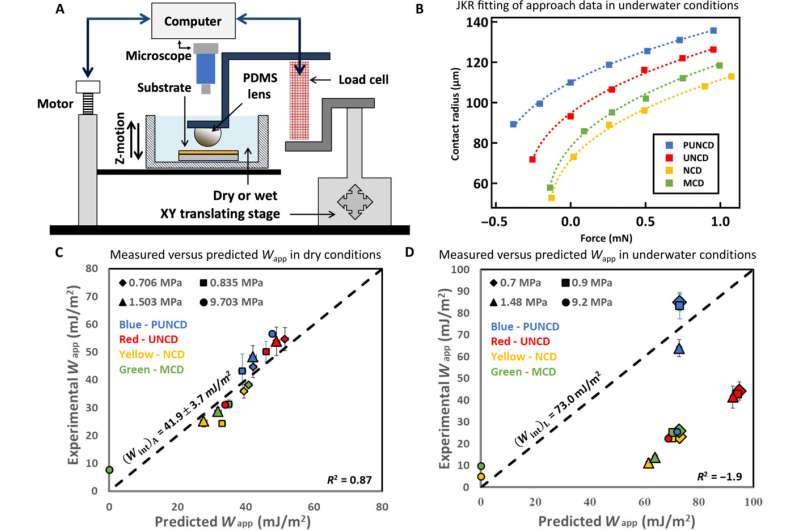This article has been reviewed according to Science X's editorial process and policies. Editors have highlighted the following attributes while ensuring the content's credibility:
fact-checked
peer-reviewed publication
trusted source
proofread
New research challenges conventional wisdom on wet surface adhesion

Scientists at the University of Akron and the University of Pittsburgh have overturned long-held assumptions in new research that finds water can be a help for adhesion.
Dr. Ali Dhinojwala, distinguished W. Gerald Austen Endowed Chair and H.A. Morton Professor at The University of Akron's School of Polymer Science and Polymer Engineering, led a team whose significant breakthrough—that water can unexpectedly enhance adhesion under controlled conditions—was published Aug. 7 in Science Advances.
The implications of this research are profound, particularly in biomedical applications such as bandages, health monitoring sensors for moist skin, and advanced adhesives that could replace sutures. The insights gained into leveraging surface roughness and material properties could revolutionize industries worth billions of dollars globally.
Driving on wet roads or applying adhesive tapes to damp skin are everyday challenges exacerbated by the difficulty of achieving strong adhesion on wet, rough surfaces. Traditionally, the presence of water has been seen as a hindrance, disrupting molecular bonds necessary for effective adhesion. Water tends to cling to surfaces and get trapped in surface roughness, further complicating the adhesion process.
In a significant breakthrough, Dr. Dhinojwala's team—including Dr. Tevis Jacobs from the University of Pittsburgh, Dr. Lars Pastewka from the University of Freiburg and Dr. Anirudha Sumant from Argonne National Laboratory—made their discovery in a study that involved measuring the adhesion of a soft elastomer to precisely engineered rough surfaces, revealing a complex interplay between water, surface roughness and adhesion dynamics.
Dr. Dhinojwala, and graduate student Nityanshu Kumar, performed the groundbreaking underwater experiments and developed models to explain the results. The rough surfaces were chemically prepared at Argonne National Lab and were characterized down to the atomic scale at the University of Pittsburgh. Simulations of the separating interface were conducted at the University of Freiburg. The investigation was only possible through the complementary expertise of this collaborative team.
Contrary to expectations, the presence of water during contact formation initially disrupts adhesion by preventing molecular contact over nearly half of the surface area due to trapped water molecules. Moreover, the energy required to deform the elastomer and conform to the surface roughness is significantly increased in the presence of water, further reducing initial adhesion.
Surprisingly, the presence of water, which disrupts adhesion during contact formation, increased adhesion by nearly four times during detachment. With the help of analytical models and surface-sensitive spectroscopy, these results showed that water is trapped in nanometer-sized pockets. "It's hard to make contact under water because extra energy is required to squeeze out the water and you can't remove it entirely," said Dr. Jacobs, "But we were very surprised to see that the same trapped water that makes it hard to push two surfaces together, also makes it significantly harder to pull the same surfaces apart."
"These findings challenge the traditional view that water universally impedes adhesion," said Dr. Dhinojwala. "By understanding how water interacts with surface topography, we can potentially harness roughness to enhance adhesion, much like how geckos use their toe pads to climb wet surfaces."
Dr. Dhinojwala's team next intends to focus on further refining these findings to develop practical applications that capitalize on the surprising benefits of water in adhesion science.
More information: Nityanshu Kumar et al, Small-scale roughness entraps water and controls underwater adhesion, Science Advances (2024). DOI: 10.1126/sciadv.adn8343
Journal information: Science Advances
Provided by University of Akron





















